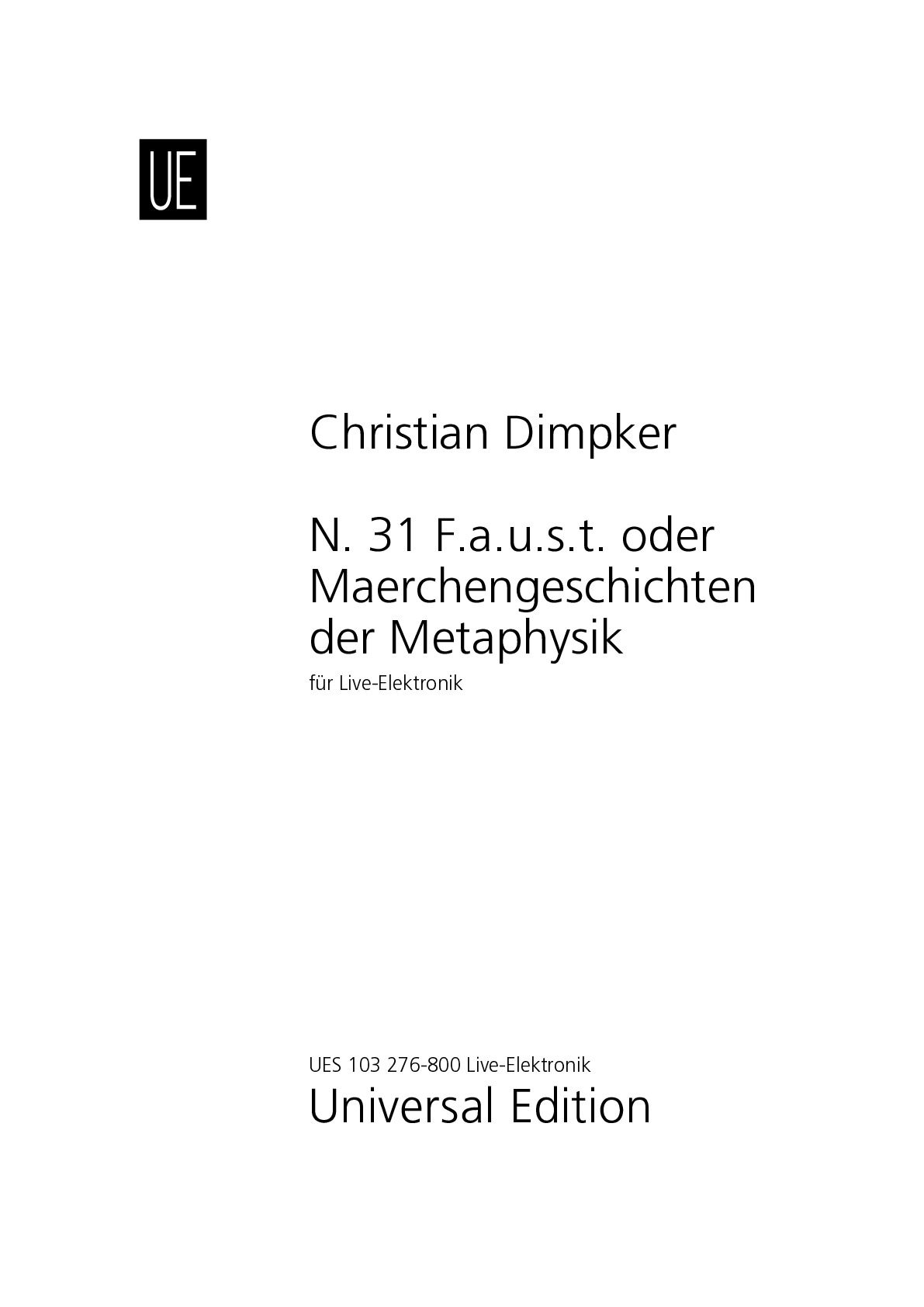

Christian Dimpker
N. 31 F.a.u.s.t. or fairy tales of metaphysics
Duration: 32'
Solos:
live electronics
N. 31 F.a.u.s.t. or fairy tales of metaphysics
Translation, reprints and more

Christian Dimpker
N. 31 F.a.u.s.t. oder Märchengeschichten der MetaphysikType: Noten
Sample pages
Work introduction
F.a.u.s.t. (Facial action unit software treatment) or fairy tales of metaphysics brings Doctor Johannes Faust’s Triple Hell Compulsion to the stage. This invocation of spirits is carried out by three experienced exorcists and a conductor. Through magic circles, consecrations and censing, they transfer creatures from hell into this world – first and foremost Mephistophieles and Bazarachiel. In addition, the work contains for the first time the novel compositional achievement of facial expression notation, which is used to gain control over the shadow creatures and to merge Faust’s abstracted drawings with a three-dimensional, media-generated world. Metaphysics is the realm of fairytales. In this piece, the separation to the physical world is abolished, as it is also practised by many patriarchal religions. By doing so, earth is here, however, enriched with colourful spirits. The piece was completely formulated by means of a score and can thus, similar to an orchestral work, be reproduced in detail again and again in different venues without the composer being present. This is the black and white version of the score, but you can access the coloured version on this page. This is the black and white version of the score, but you can access the coloured version on this page.
What is necessary to perform this work?
F.a.u.s.t. is short for Facial action unit software treatment. The work is based on Doctor Johannes Faust’s Magia naturalis et innaturalis or triple hell compulsion from 1505 and is supposed to be performed at a theatre as a prelude to a drama based on the Faust material or be combined with some of my (musical) works. The performers are three actresses (this form intends to include any person / gender / identity) who have enjoyed classical instrumental training or, for instance, also (opera) singers or instrumentalists with acting experience. To facilitate the performance, simple tempo and time signatures are employed. Moreover, a conductor guides all actions (including light and sound), balances deviations and thus shatters the illusion of the devil’s incantation. She needs two portable lights, so that the directions can also be seen in darkness and moves on the stage according to the actions (like a referee). Scores may be distributed at different spots if they do not interfere with the paths the players walk. If it makes sense, a small platform for the conductor can also be built laterally in front of the stage. Further, the basic structure of the work can be seen on p. V. There are three times two televisions on the stage, while the upper TVs stand on tables and the lower TVs are placed directly in front of the tables or are enclosed in them. The upper TVs show three different animations, which are partly controlled by the facial expressions of the three actresses. The actresses themselves disappear behind the screens. However, the lower TVs show the (alienated) faces of the actors in real-time. Two video cameras are needed for each table. Two of these cameras are also strapped to the actresses’ heads with a belt and, respectively, attached to the stands during the course of the play. The animations are controlled from the corresponding table, but the actresses’ faces are transmitted from table 1 to the lower TV of table 3, from table 2 to table 1 and from table 3 to table 2 (as indicated). In addition, large (LED) screens in the back of the stage also show the animations of the TVs (ad libitum, depending on the size of the house). For this purpose, the image of TV 2 is rotated clockwise by 90° and reproduced on screen 3, the image of TV 4 is rotated counter-clockwise by 90° and reproduced on screen 1 as well as the image of TV 6 is rotated clockwise by 90°, horizontally mirrored and reproduced on screen 2. The resolution should be at least 1920 × 1080 pixels (digital cinema) and the aspect ratio 1.78:1 (16 × 9). The screens stand as far back on the stage as possible. In addition, one microphone each is placed at table 1 and 3 and two microphones in XY arrangement are positioned at table 2 (while all microphones have a cardioid polar pattern). The microphone of table 1 sends (as indicated) to loudspeaker 2 and the microphone of table 3 to loudspeaker 1. This is achieved by a wide panning setting, but the signal from the other speaker is not completely muted. Moreover, the microphones of table 2 send to both loudspeakers. All other parameters are discussed in detail on the following pages. For further information see Dimpker: Kinetic notations for the visual and performing arts.
The following industrial goods are also needed: three layers of three-finger wide Dutch paper onto which the magic circles are projected. Five wax candles consecrated according to the law, which have burned on an altar. They are placed in all four parts of the magic circle as shown on p. V. The fifth light remains under table 2. The lights are secured by round, transparent mica shields and are lit with three long lighters. Further materials needed are: frankincense, myrrh, mastic and aloe, crushed to a powder (1st censing). Barrel pitch and sulphur crushed to a powder (2nd simulated censing). Garlic and Christmas rose / black hellebore (Helleborus niger) crushed into a powder (3rd censing). Juniper wood, buckthorn wood and doorwood chips (4th censing). For powders 1, 3 and 4, unused iron censers with handles (and cast-iron coasters) are needed and for powder 2 a clay bowl. The first three powders lie on white paper at the beginning of the piece. The fourth material is already prepared in a censer and will be handed onto the stage at the appropriate time. In addition, three bibles, two kettles of holy water, a spray can of red paint, a rapier, a new broom and a respirator mask (as indicated under the tables) must be obtained. If it is not possible to perform the censings at a theatre for safety reasons, they can be simulated. For this purpose, portable fog machines (steam lies on the floor) or hazers (steam spreads evenly in the room) can be installed in the pots and the ignition of the charcoal be faked (see score for details).
The text recited by the exorcists I-III (E I-III) is provided in German and English. It may and can be translated into all languages. In the score, the first words of every speech are given. The index numbers serve as points of reference. The full text can be found in the appendix. It may be copied and used along with the score. When the players are behind the TVs, they may read the text out loud. If the translation results in shorter / longer passages, the tempo may be slightly raised / lowered.
